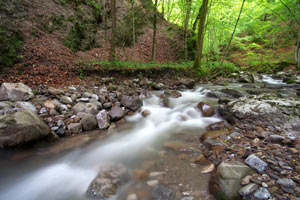
- The TRUTH About America's Water
- Water Pollutants that Cause Illness
- Are Minerals in Water Important for Health?
- Top 5 Drinking Water Contaminants
- Do I Need a Whole House Water Filter?
Natural Purification of Liquid Water on Earth
Before we dig into the main topic, it is important to have an idea over the water cycle in nature, therefore understanding how water quality is falling and then purifying.

The hydrological cycle is the cycling of water molecules from the ocean to the atmosphere, then to the land and back to the ocean, or the storage in various reservoirs.
Let’s elaborate on its journey now: water evaporated from the ocean eventually condenses as water droplets in clouds. If the cloud grows large enough, the droplets coalesce and fall as precipitation, mostly as rain, sometimes as snow or ice when the temperature is very low. 74% of all water evaporated into the atmosphere falls as precipitation on the ocean, mostly in the tropics. 26% falls on the land. But the distribution of rainfall is very uneven.
Some of the water runs into streams, lakes, and rivers, which return the water to the ocean while some soaks into the ground (infiltrates) and becomes groundwater. The water then can percolate deeper into the ground supplying water to subsurface reservoirs. The rate of infiltration depends on: many factors such as the type of soil. Sandy soils absorb water faster than clay soils. Vegetation can also tend to delay runoff. While the water content of the soil also plays an important role. Soils saturated with water absorb little more. The rainfall rate, whether a tremendous amount is a short period or a prolonged period, have different absorption rate. Some rainfall evaporates back into the air, or it is absorbed by plants, which transpire the water into the air. This is called evapotranspiration. Evapotranspiration describes the transport of water into the atmosphere from surfaces including soil, and from vegetation (transpiration). This process is one of the main consumers of solar energy at the Earth’s surface.
Purification of water in liquid form ultimately depends on natural filtration, chemical absorption and adsorption by soil particles and organic matter, living organism uptake of nutrients, and living organism decomposition processes in soil and water environments. Human activities that compact soil, degrade soil structure in other ways, contaminate storm water with pollutants, or alter the composition of soil and water-based organisms, eventually reduce or retard the natural water purification process and cause accelerated movement of unfiltered water through the system and into our water supplies.
Soils, especially in wetland and riparian areas, along with vegetation and microorganisms play very important roles in natural water purification. Microorganisms in soils, wetlands and riparian areas either utilize or breakdown numerous chemical and biological contaminants in water.





